Hidden within the bustling streets of Little India lies a treasure trove of architectural wonders waiting to be discovered through the lens of street photography. Vibrant and colorful, this cultural enclave boasts a unique blend of styles, reflecting the diverse influences that have shaped its identity over the years.
But did you know that behind the vibrant facades and ornate details, there are stories waiting to be told? From the intricately carved shophouses to the awe-inspiring temples, each structure holds a piece of history that begs to be explored.
So grab your camera and join us on a journey through the enchanting world of Little India’s architecture, where every corner reveals a captivating tale just waiting to be captured.
Good To Know
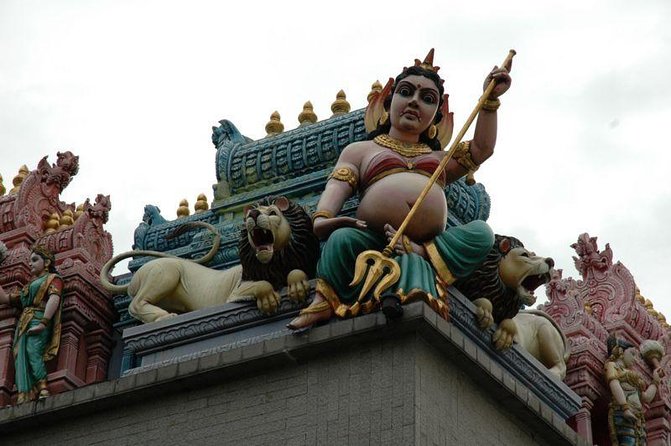
- Little India’s architecture showcases a vibrant blend of cultural influences from Indian, Chinese, Malay, and European styles.
- The best time for photography in Little India is during the early morning golden hour to capture the vibrant colors and local life in action.
- Sri Veeramakaliamman Temple, House of Tan Teng Niah, Abdul Gafoor Mosque, and Little India Arcade are top architectural highlights to visit and capture in photographs.
- When capturing street photography in Little India, use techniques like fast shutter speed, wide aperture, ISO adjustments, rule of thirds, and leading lines to create visually pleasing compositions and capture candid moments of daily life.
Overview of Little India’s Architecture
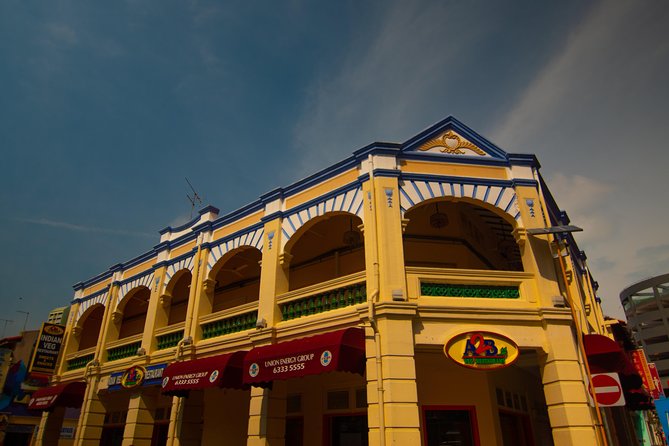
Little India’s architecture showcases a vibrant blend of cultural influences, making it a captivating destination for architecture enthusiasts and photographers alike. With its rich history, the buildings in Little India tell stories of the diverse communities that have settled in the area over the years.
The architecture reflects the cultural melting pot that’s Singapore, with influences from Indian, Chinese, Malay, and European styles. As you wander through the streets of Little India, you’ll find yourself surrounded by colorful shophouses adorned with intricate facades and ornate detailing.
The best photo spots in Little India include the iconic Sri Veeramakaliamman Temple, featuring stunning Dravidian architecture, and the beautifully restored House of Tan Teng Niah, known for its vibrant rainbow-colored façade.
Exploring the history of Little India’s architecture is like stepping into a time capsule, where the past seamlessly blends with the present.
Like taking photos? Other Singapore photography tours we've covered
Best Time to Visit Little India for Photography
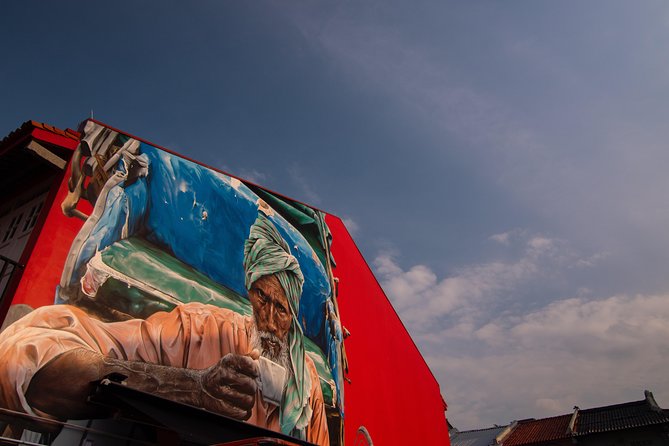
The optimal time to capture the vibrant essence of Little India in your photographs is during the early morning hours, when the soft golden light bathes the streets in a warm glow. This is commonly known as the ‘golden hour,’ a period of time shortly after sunrise when the light is soft, diffused, and perfect for photography.
During this time, the colors of Little India come alive, with the vibrant hues of the buildings, the colorful saris of the locals, and the intricate details of the architecture all shining brilliantly in the morning light.
It’s also the best time to capture the local life in action, as the streets slowly come to life with people going about their daily routines. By venturing out early, photographers have the opportunity to capture the essence of this lively neighborhood in its most authentic and captivating state.
Top Architectural Highlights in Little India
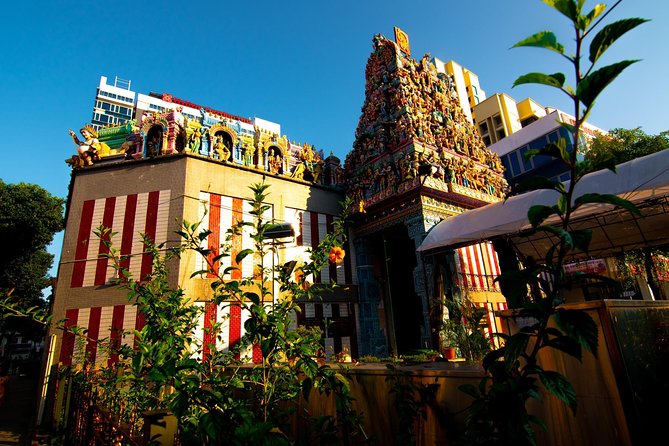
As the golden hour casts its enchanting light over the streets of Little India, photographers are drawn to the architectural wonders that adorn this vibrant neighborhood. Little India is a treasure trove of stunning buildings and landmarks that provide endless opportunities for capturing unique and captivating photographs.
Here are some of the top architectural highlights that every photographer should explore:
Sri Veeramakaliamman Temple: This iconic Hindu temple is a must-visit for its intricate carvings, vibrant colors, and stunning statues. It’s a photographer’s dream come true.
The House of Tan Teng Niah: Known for its vibrant rainbow-colored exterior, this historic Chinese villa is a favorite among photographers for its unique charm and photogenic appeal.
Abdul Gafoor Mosque: With its stunning blend of Indian and Islamic architectural styles, this mosque stands out as a beautiful and photogenic landmark in Little India.
Little India Arcade: This bustling street is home to a variety of traditional shophouses, each with its own unique architectural style. Photographers can capture the vibrant colors and intricate details of these buildings, making it a must-visit location.
When exploring these architectural highlights, photographers should make sure to bring their best camera equipment to capture the intricate details and vibrant colors of these famous landmarks in Little India.
Tips for Capturing Street Photography in Little India
Looking to capture the vibrant energy and unique charm of Little India through street photography? To help you make the most of your experience, here are some valuable tips on camera settings and composition techniques to enhance your shots.
Camera Settings:
- Shutter Speed: Use a fast shutter speed to freeze the dynamic movements of people and vehicles on the busy streets.
- Aperture: Opt for a wide aperture (low f-stop number) to create a shallow depth of field and make your subject stand out against the colorful backdrop.
- ISO: Adjust your ISO settings to maintain a good balance between capturing details and avoiding excessive noise in low-light conditions.
Composition Techniques:
- Rule of Thirds: Place your subject off-center using the rule of thirds grid to create a more visually pleasing and balanced composition.
- Leading Lines: Utilize the lines and curves of the streets, buildings, and market stalls to guide the viewer’s eye through your photograph.
- Candid Moments: Capture genuine moments of daily life in Little India by observing and photographing people in their natural environment.
Little India’s Colorful Streets and Buildings
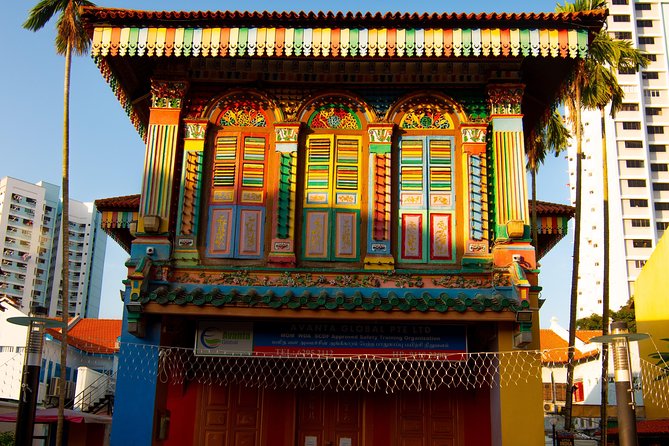
Little India’s streets and buildings come alive with a vibrant burst of color, creating a captivating visual tapestry that immerses visitors in the rich cultural heritage of this bustling neighborhood.
As one explores the colorful streets of Little India, they’ll find themselves surrounded by a kaleidoscope of hues that seem to dance in harmony. The architectural details found in the buildings further enhance the visual spectacle, showcasing intricate designs and patterns that reflect the cultural influences of the area.
From the ornate facades adorned with vibrant murals to the intricately carved pillars and arches, every corner of Little India offers an opportunity to capture vibrant colors and architectural details. Visitors can marvel at the buildings’ unique blend of Indian, Chinese, and European influences, creating a truly captivating experience for photographers and enthusiasts alike.
- Tiger Brewery, Swim & Sunset Photo Session at Raffles Marina
- Walking Tour in Little India Singapore
- Vegetarian Culinary Adventure in Singapore
- Two Simulated Indoor Skydiving Experiences – Sentosa Island
- Try Find Better Than Us! Airport Transfer Service in Singapore APT-HTL (Sin)
- VIP Private Singapore Highlights Tour
Unique Architectural Styles in Little India
The vibrant streets and buildings of Little India not only showcase a mesmerizing array of colors, but also boast a diverse range of unique architectural styles that reflect the neighborhood’s rich cultural heritage.
From the ornate facades of traditional shophouses to the grandiose structures of ancient temples, Little India is a treasure trove of architectural wonders. Each building tells a story, capturing details and unique elements that transport you to a different time and place.
The intricate carvings, vibrant murals, and colorful tiles are a testament to the craftsmanship and artistic flair of the local community. As you wander through the streets of Little India, be sure to take a moment to appreciate the architectural beauty that surrounds you, for it’s a true reflection of the neighborhood’s vibrant and diverse identity.
Exploring the Cultural Significance of Little India’s Architecture
With its rich cultural heritage and vibrant array of architectural styles, Little India’s buildings are a captivating reflection of the neighborhood’s cultural significance. The history of Little India’s architecture is deeply intertwined with the colonial past of Singapore.
Here are some insights into the impact of colonialism on Little India’s architecture:
Colonial Influence: The architecture in Little India bears the imprint of British colonial rule, with many buildings featuring Victorian and British colonial design elements. The grand facades and intricate detailing showcase the influence of the British on the neighborhood’s architecture.
Preservation of Heritage: Little India’s architecture also reflects the efforts to preserve its cultural heritage. Traditional shophouses with their unique blend of Indian and Peranakan architectural styles can still be found, showcasing the neighborhood’s rich cultural diversity.
Symbolic Significance: The architecture in Little India serves as a visual representation of the Indian community’s presence and contribution to Singapore’s multicultural fabric. The buildings stand as a testament to the resilience and identity of the Indian community in the face of colonialism.
Cultural Landmarks: Little India’s architecture is home to iconic landmarks such as the Sri Veeramakaliamman Temple and the House of Tan Teng Niah. These structures not only showcase the architectural beauty but also hold cultural and religious significance for the community.
The architecture in Little India tells a story of cultural resilience, colonial influence, and the celebration of heritage. It’s a living testament to the neighborhood’s rich history and cultural significance.
Where to Find Hidden Gems for Photography in Little India
Tucked away amidst the bustling streets of Little India, one can uncover a stack of hidden gems perfect for capturing stunning photographs. For those seeking unique shots, exploring the hidden alleys of Little India is a must. These narrow passageways are adorned with colorful street art, intricate murals, and traditional Indian architecture, providing endless opportunities for creative compositions.
The vibrant markets of Little India also offer a treasure trove of photographic subjects. From the vibrant displays of fresh produce to the bustling crowds haggling over goods, these markets are a feast for the senses and a haven for street photographers.
Whether it’s the hidden alleys or the vibrant markets, Little India is a photographer’s paradise, waiting to be discovered and captured through the lens.
Common Questions
How Can I Book the Little India Architecture and Street Photography Tour?
To book the Little India architecture and street photography tour, visitors can follow the easy booking process. A vibrant and engaging tour itinerary will be provided, allowing participants to explore the rich cultural heritage of Little India.
Is the Tour Suitable for Individuals With Limited Physical Fitness?
The tour offers accessibility options for individuals with limited physical fitness. If the Little India tour is not suitable, there are alternative tours in Singapore that are recommended for those with limited physical fitness.
What Is the Maximum Number of Travelers Allowed on the Tour?
The maximum number of travelers allowed on the tour is 10. This ensures a personalized and intimate experience for each participant, allowing them to fully enjoy the Little India Architecture and Street Photography tour.
What Is the Cancellation Policy for the Tour?
The cancellation policy for the tour is non-refundable and non-amendable. However, if there is a minimum number of travelers required for the activity to proceed, rescheduling options may be considered.
How Can I Contact Viator Help Center if I Have Any Questions or Concerns?
To resolve issues with Viator bookings, travelers can contact Viator customer support. They can reach out to the Viator Help Center for any questions or concerns they may have, ensuring a smooth and satisfactory experience.
The Sum Up
Little India in Singapore is a vibrant and culturally rich neighborhood that offers a feast for the eyes of any photography enthusiast. From the colorful streets and buildings to the unique architectural styles, there’s no shortage of beauty to capture.
With the guidance of a professional photographer, participants can gain valuable insights and tips on capturing the essence of this cultural enclave. Whether you’re a seasoned photographer or just starting out, Little India is a must-visit destination for capturing stunning architecture and street photography.
More Photo Tours in Singapore
- Instagrammable Photoshoot Experience in Unique Singapore Locale
- Holiday Experience With Private Local Photographer in Singapore
- Gardens By The Bay Night Long-Exposure Photography
- Jurong Bird Park Bird Photography
- Beach Road Hawker Center Food Photography Tour in Singapore
- Hire Photographer, Professional Photo Shoot – Singapore
More Tour Reviews in Singapore
Looking for something different? Other Singapore activities we've written about
- Art Jamming Workshops
- 25 Best Guided Tours In Singapore
- 8 Best Shopping Tours In Singapore
- 25 Best Tours In Singapore
- 5 Best Sailing Experiences In Singapore
- 20 Best Historical Tours In Singapore
- 17 Best Workshops And Classes In Singapore
- 5 Best 3 Day Tours In Singapore
- 15 Best Full-Day Tours In Singapore
- 25 Best Boat Tours And Cruises In Singapore
- 10 Best Safari Tours In Singapore
- 19 Best Photography Experiences In Singapore
